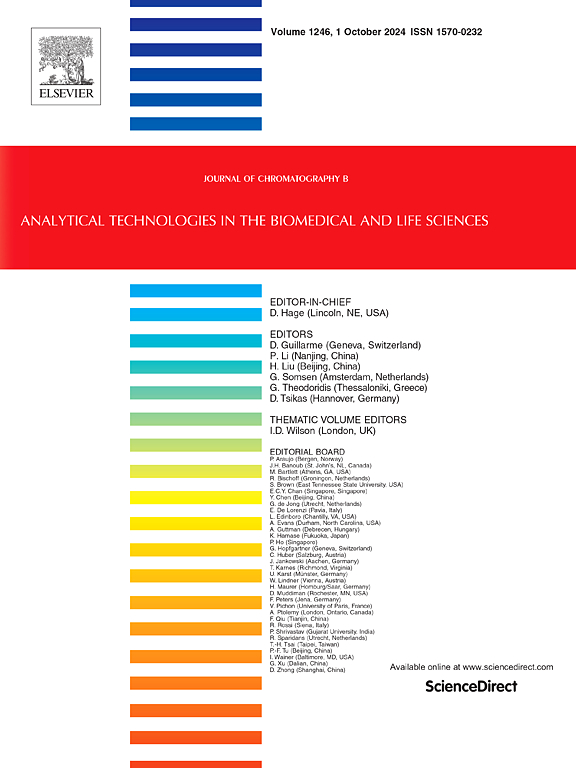利用 LC-MS/MS 快速定量人体肺上皮内衬液中的多粘菌素 B 及其临床应用
IF 2.8
3区 医学
Q2 BIOCHEMICAL RESEARCH METHODS
引用次数: 0
摘要
肺上皮内衬液(ELF)通常用于下呼吸道感染的药代动力学研究。为了确定多粘菌素 B 在气溶胶给药后的肺内药代动力学特性,我们开发并全面验证了一种液相色谱/串联质谱(LC/MS/MS)方法,用于定量检测人支气管肺泡灌洗液(BALF)中的多粘菌素 B。多粘菌素 B 的 ELF 浓度是根据 BALF 中的多粘菌素 B 值计算得出的,并使用尿素作为体积归一化。色谱分离采用 Phonomenex Kinetex XB-C18 色谱柱(内径 100 mm × 2.1 mm,2.6 μm),以乙腈和含 0.2 % 甲酸的水为流动相。流速设定为 0.4 mL/min,运行时间为 3.5 分钟。蛋白沉淀用于制备 BALF 样品,多粘菌素 E1 作为内标。在多反应监测条件下,使用电喷雾电离界面以正离子模式检测多粘菌素 B。在支气管肺泡灌洗液中多粘菌素B1/B2的检测浓度范围为0.0300/0.00306--10.0/1.02 mg/L(R2 >0.99),检测结果呈良好的线性关系。该方法的日间和日间精密度(RSD, %)分别为12.2%(LLOQ样品为15.2%)和94.3%~110.4%。这种可靠的LC-MS/MS多粘菌素B检测方法被成功地应用于气雾剂给药后患者的肺渗透研究。本文章由计算机程序翻译,如有差异,请以英文原文为准。
Rapid quantification of polymyxin B in human pulmonary epithelial lining fluid by LC-MS/MS and its clinical application
Pulmonary epithelial lining fluid (ELF) was commonly used for the pharmacokinetic study in lower respiratory tract infections. To characterize the intrapulmonary pharmacokinetic properties of polymyxin B following aerosol delivery, we developed and fully validated a liquid chromatography/tandem mass spectrometry (LC/MS/MS) method for quantifying polymyxin B in human bronchoalveolar lavage fluid (BALF). The ELF concentrations were calculated by the BALF values of polymyxin B using urea as a volume normalizer. Chromatographic separation was achieved on a Phonomenex Kinetex XB-C18 column(100 mm × 2.1 mm I.D., 2.6 μm)in acetonitrile and water both containing 0.2 % formic acid. The flow rate was set as 0.4 mL/min for a 3.5 min running time. Protein precipitation was used in preparing BALF samples with polymyxin E1 as an internal standard. Polymyxin B was detected under multiple reaction monitoring conditions using the electrospray ionization interface running in the positive ionization mode. The assay showed a good linear relationship over the tested concentration ranges of 0.0300/0.00306–––10.0/1.02 mg/L for polymyxin B1/B2 in bronchoalveolar lavage fluid (R2 > 0.99). The inter- and inter-day precisions (RSD, %) were < 12.2 %(15.2 % for LLOQ samples)and the accuracies (%) were within the range of 94.3 ∼ 110.4 %. This reliable LC–MS/MS method for detection of polymyxin B was successfully applied to conduct a pulmonary penetration study in patients following aerosol administration.
求助全文
通过发布文献求助,成功后即可免费获取论文全文。
去求助
来源期刊

Journal of Chromatography B
医学-分析化学
CiteScore
5.60
自引率
3.30%
发文量
306
审稿时长
44 days
期刊介绍:
The Journal of Chromatography B publishes papers on developments in separation science relevant to biology and biomedical research including both fundamental advances and applications. Analytical techniques which may be considered include the various facets of chromatography, electrophoresis and related methods, affinity and immunoaffinity-based methodologies, hyphenated and other multi-dimensional techniques, and microanalytical approaches. The journal also considers articles reporting developments in sample preparation, detection techniques including mass spectrometry, and data handling and analysis.
Developments related to preparative separations for the isolation and purification of components of biological systems may be published, including chromatographic and electrophoretic methods, affinity separations, field flow fractionation and other preparative approaches.
Applications to the analysis of biological systems and samples will be considered when the analytical science contains a significant element of novelty, e.g. a new approach to the separation of a compound, novel combination of analytical techniques, or significantly improved analytical performance.
 求助内容:
求助内容: 应助结果提醒方式:
应助结果提醒方式:


